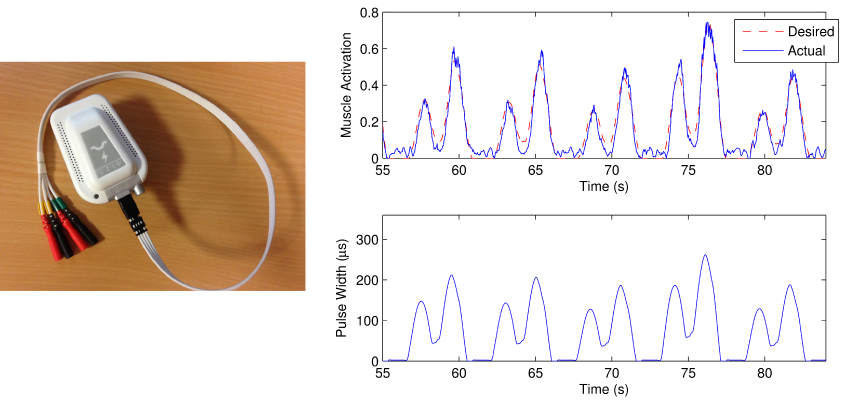Section: New Results
Synthesis and Control of Human Functions
FES-cycling and participation to Cybathlon competition
Participants : Christine Azevedo Coste, Benoît Sijobert, Charles Fattal [CRF DIVIO, Dijon, France] , Antonio Padilha [UNB, Brasilia, Brazil] , Emerson Fachin Martins [UNB, Brasilia, Brazil] , David Andreu.
DEMAR and University of Brasilia will jointly participate with two SCI pilots to Cybathlon - FES-Bike competition. Cybathlon intends to promote assistive technologies during a competition. Two trikes will be adapted, an original control strategy will be proposed and two paraplegic individuals (one from Brazil and one from France) will be trained during the upcoming year. The protocol will be submitted to CPP ethical committee for agreement in the coming weeks ( http://freewheels.inria.fr/ ).
PersoStim: A Personalized Closed-loop FES Control of Muscle Activation with Evoked EMG Feedback
Participants : Mitsuhiro Hayashibe, Zhan Li [University of Electronic Science and Technology of China] , David Andreu, David Guiraud.
Functional electrical stimulation (FES) is a useful technique for restoring motor functions for spinal cord injured (SCI) patients. Muscle contractions can be artificially driven through delivery of electrical pulses to impaired muscles, and the electrical activity of contracted muscles under stimulus recorded by electromyography (EMG) is called M-wave. The FES-induced muscle activation which is represented by evoked EMG recordings can indicate the muscle state. Accurate control of muscle activation level by FES is the first step toward achieving more complicated FES control tasks.
A new FES closed-loop control strategy, EMG-feedback predictive control (EFPC), was developped to adaptively control stimulation pattern compensating to time-varying muscle state changes such as muscle fatigue and stimulation electrode detachment, along with the consideration of the personalized muscle responses to the electrical stimulation. This software manages a real-time FES system for control of muscle activation by online modulating pulse width of stimulus. The excitation muscle dynamics is modelled by Hammerstain system with stimulus pulse width and eEMG as input and output respectively. The model predictive control strategy is adopted to systematically produce the pulse width command of the stimulator. It is implemented together with Vivaltis portable stimulator. Four reference muscle activation patterns are provided to test and validate the real-time closed-loop FES control system. Real-time control results show promising control performances.
Recently, this software was demonstrated at the event of Rencontre Inria-Industrie 13/10/2015 at Bordeaux. https://www.inria.fr/centre/bordeaux/innovation/rii-sante/demonstrations2
|
Direct spinal stimulation for rehabilitation of bladder, bowel and sexual functions in spinal cord injury
Participants : Christine Azevedo Coste, Luc Bauchet [CHU Montpellier] , Claire Delleci [CHU Bordeaux] , Charles Fattal [CRF DIVIO, Dijon, France] , Thomas Guiho, David Guiraud, Jean-Rodolphe Vignes [CHU Bordeaux] .
Complete spinal cord injury results in loss of movement and sensory sensations but also in function of organs. For example, nearly all spinal cord injured subjects lose their bladder control and are prone to kidney failure if they do not apply intermittent (self-) catheterization. Electrical stimulation of the sacral spinal roots with an implantable neuroprosthesis is one option besides self-catheterization to become continent and control micturition. However, many persons do not ask for this neuroprosthesis since deafferentation and loss of sensory functions and reflexes are serious side effects. Spinal cord stimulation (SCS) is a general term which includes both epidural and intradural stimulation. Originally associated with the treatment of chronic neurogical pain (in the 1970ies), SCS led also to immediate and profound improvements of sensory and motor functions in recent studies both on SCI patients (only on very few case studies) and rodents. Despite these promising results some limitations have still to be overcome. Among them, the use of small animal models, the empirical aspect of the stimulation procedure and the impact of these protocols on intestinal and urinary functions are critical. To counteract these limits, we want to explore intradural and epidural stimulations in an intermediate model- the house pig- and assess their impact on bladder, guts and genitals. In order to evaluate our approach, we will record EMG signals of lower limbs and sphincters (both urethral and anal), and simultaneously, we will monitor bladder and rectal pressure.
Already preliminary experimental explorations were performed with direct spinal cord stimulation in June (on 2 animals). Experiments were conducted under neurosurgeons involved in the project and urodynamics was recorded together with rectum pressure and sphincters EMG during each stimulation session.



